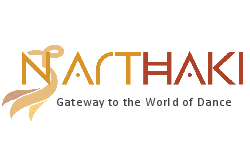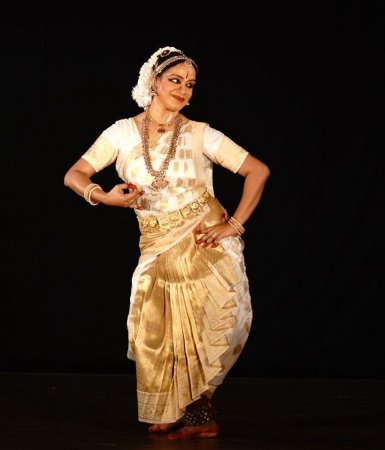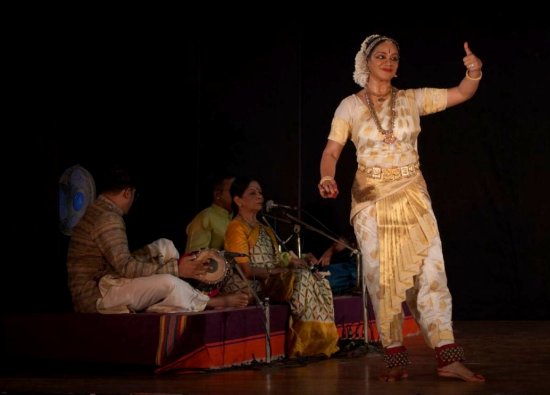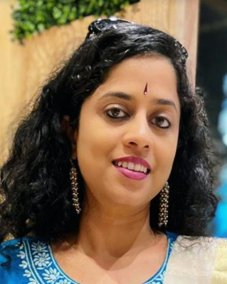
|   |

|   |
An auspicious beginning with beautiful Bharatanrityam - Sumana Sachidananda e-mail: sumanas29@gmail.com Photos: Ashwin Vijay April 13, 2025 Gudi Padwa, which marks the start of the lunisolar Hindu year in Maharashtra, is celebrated with great fervour and festivity in Mumbai. As a city of migrants, Mumbai dials up the pomp and show on this day to show the world what Marathi pride truly is. Stunning parades and bike rallies feature youngsters dressed to kill, in their "Nauvvaris" and dhoti-kurtas along with phetas (turbans). It is believed that there is a powerful cosmic alignment on this day, and that the northern hemisphere receives the highest amount of the sun's energy during the 21 days that follow. The sun is not merely a star in the solar system for Indians. In fact, our ancient culture regards the sun as a planet, worthy of worship as "Surya Deva". Aishwarya Harish, the young torchbearer of Bharatanrityam in Mumbai, presented 'Uttaraayana Maargam', a pathbreaking recital that showcased the rich tapestry of the traditional Maargam of Bharatanatyam, entirely centred around the Sun God. It was showcased at the NMACC on the 30th of March, which happened to coincide with the auspicious occasion of Gudi Padwa. Sheer serendipity or masterful curation - either way, this transformed into a sacred journey for all the rasikas who were regaled by the stories of Surya Deva presented by Aishwarya. Uttaraayana is the holy period of the year when the Sun moves northward towards the Tropic of Cancer. It is manifested through longer days and increased solar energy in the northern hemisphere. One must commend the magnificent cerebral effort that has gone into this presentation on all fronts - nrithya, sahitya and sangeeta. Aishwarya is the daughter/disciple of Guru Jayashree Rajagopalan, one of the veteran dancers of Mumbai, who is known for her remarkable poise and adherence to tradition. She has received advanced training from the genius luminary herself, Dr. Padma Subrahmanyam, and has studied various texts to conceptualise this solo production. Right from the Pushpanjali until the Tillana, every piece presented a unique facet of Surya and was created from scratch. Only years of research, skill and creative visualization can give birth to something as vivid as this. The rasikas were offered several rare delicacies in the form of Awadhi language Varnams and Surya Ragam krithis, on this new year day.  Aishwarya commenced with the Pushpanjali - Om Bhaaskaraaya Namaha - where she paid obeisance to the Guru, the stage, the audience and the guardians of the directions (Ashtadigpalakas). This was followed by the evergreen Natyasangeet in Marathi - Tejonidhi loha gol. The line "Daahak pari sanjeevak tarunaaruna kirana prabha" captures the essence of the sun in our lives, as it says that the heat of the sun rays can be blistering at times, but the sun's illumination has the power to rejuvenate the young and old alike. Can a single organism survive on earth without the grace of the sun god? With verses incorporated from the Natyashastra and the Bharataarnava, this piece made for a spirited start to the recital. Aishwarya cleverly titled each piece with the specific name of Surya which was relevant to the content presented in that piece. Since this was about the radiance of Surya, it was called "Om Bhaaskaraaya Namaha". This was followed by the Kautvam - Om Suryaaya Namaha - that highlighted the divinity of Lord Surya who transforms into the Trinity as the day goes by - at dawn he is the gentle Brahma (Brahmasvarupa udaye), at midday he is the raging Mahadeva (Madhyahne tu maheshvaraha), and at dusk he is the calm Vishnu (Asthakale swayam Vishnuhu). The lines were from the stanzas of Shiva Prokta Surya Stotram, which is deeply poetic and raises the stature of the Sun God, likening him to the trinity. The Kautvam which has nritta syllables interspersed with lyrics, is a traditional piece that was performed regularly in the ancient times as hymns in praise of a particular god / goddess. Aishwarya's dance has the strong footwork (tatta) of conventional Bharatanatyam, but also the softer footwork that the Bharatanrityam style demands. Dr. Padma Subrahmanyam has created a highly appealing style with elements of both Maargi (as per Natyashastra) and Desi (regional Bharatanatyam), that require the dancer to engage the Ang, Pratyang and Upang to a much greater degree than in any other classical dance form. The Jathiswaram - Om Hiranyagarbhaaya Namaha - in raga Revathi, brought forth the 'sprouting movements' of life, as Aishwarya described the Surya Namaskaar which was the highlight of this piece. The sun being the most effulgent life-giving force, forms a visible representation of the invisible almighty, and hence becomes the best physical entity for worship and meditation. The sun salutation was performed with great ease and precision by Aishwarya. While Yoga is intrinsic to classical dance, it was refreshing to see it being presented in its pure form, accompanied by the prescribed mantras for each asana. Aishwarya's execution of the nritta phrases was flawless and razor sharp. The amalgamation of the Karanas with traditional adavus gives the dance form a whole lot of curved movements, in addition to the conventional linear ones. Imagine Lord Mahadev dancing his Tandava with Ganga meandering about, twisting and turning in sync - their union could possibly represent a personification of the Bharatanrityam style. The next item Surya Krithi - Om Mitraaya Namaha - highlighted the might of Surya as a formidable friend to those in need. Written by Lalitha Sivakumar in Tamil, it says "Kaarya kaarana swarupane" meaning that the sun is the causal force behind every action in the universe, and he unfailingly fulfils his duties towards all. This is a fine composition which isn't performed often, in either music or dance. The mishra chapu talam makes it all the more challenging, but Aishwarya's dancing was effortless. She can dance non-stop without huffing and puffing, which speaks of the intense riyaaz she puts herself through, under the watchful eye of her mother/Guru. The mukha-abhinaya in Bharatanrityam is dramatic and persuasive. The most subtle emotions can be conveyed with just the eyes and eyebrows. The usage of the Upangas - lips, jaws, nose, cheeks and the eyelashes among others is pronounced. The Karanas which are sculpturesque movements (not poses mind you), demand extreme flexibility, agility, grace, balance and control. Aishwarya managed to implement all her profound ideas and thoughts in her dance displaying the aforementioned qualities, which is commendable.  The second half of the evening brought to life the stories of the Surya Vanshi, Surya Anshi, Surya Putri and Surya Sadhak. It was a pleasant surprise to see a Varnam woven with verses from Sant Tulsidas's Ramcharit Manas in Surya Vanshi - Rama. While this piece didn't speak of any direct reference of the sun god, it spoke of the love story of the scion of the Suryavamsha dynasty - Raghava. It was a fantastic display of Dr. Padma Subrahmanyam-inspired abhinaya that is classical yet theatrical. "Kankana kinkini nupur dhuni suni, Kehat lakhan san Raam hriday guni", and the following lines describe a smitten Rama who can't stop admiring Sita's beauty, during their first chance encounter in the garden of Mithila. This piece was soaked in shringaara rasa, and was the clear winner in the entire presentation. Innovative on every front, and quintessential Bharatanrityam. The swaying hip and torso movements which may not conform to our rigid notions of classicism, lend themselves seamlessly to the overall form if executed well. After all, these are innate to an Indian woman's femininity, and heighten the lavanya element of dance. Aishwarya looked regal as she breezed her way through this piece, bringing alive the unconditional love between Rama and Sita. I especially enjoyed the bit where Rama gazes at Sita like the Chakora bird gazes at the full moon, while Lakshmana chuckles at the sight of his lovelorn brother. In Surya Anshi - Gayatri, Aishwarya depicted the five faces of Sanatani Devi Gayatri, who is the goddess of wisdom and the ultimate truth. As an embodiment of the supreme consciousness, she represents the synergy of Durga, Lakshmi, Saraswati, Bhudevi and Aakashadevi. The most sacred of all mantras, the Gayatri Mantra invokes the sun god, and is regarded as the pathway to the highest meditative state. Gayatri Devi is the personification of this mantra and is revered as Veda Mata. Aishwarya's portrayal of the goddess and her significance was sublime. Perhaps many in the audience who knew the Gayatri Mantra by rote, didn't know about the philosophy and essence of Devi Gayatri until they witnessed this enlightening presentation. In Surya Putri - Yamuna, Aishwarya presented the story of Surya's daughter Yamuna, an inseparable entity in the life of Lord Krishna, through the verses of Yamunashtakam. Yamuna is the sister of Yama, the daughter of Surya, the beloved of Krishna and the one who originates from the Kalinda mountain. Aishwarya's depiction of Yamuna Devi who has witnessed every one of Krishna's leelas was enchanting. The stories of the Bharatiya rivers are timeless and this was like watching a painting of Brajbhoomi come alive. The concluding piece was on Hanuman, the Surya Sadhak or the Surya Shishya. The much-loved story of how Hanuman mistook the sun for a fruit and tried to swallow it was presented delightfully. His journey thereon, to become the prime disciple of Surya was inspiring to watch. What followed was a series of episodes from the Sundarakanda which never fails to entertain the audience. Aishwarya illustrated the various boons received by Hanuman from his Guru, which helped him in the aftermath of Sita's kidnapping by Ravana. He could become as small or big as he liked, he could shine like the brilliant sun and could help resolve situations with his astute intelligence. Aishwarya transformed into Hanuman through her impeccable body language and facial expressions. She received several rounds of applause every time she became Hanuman, especially when she showed him tearing his chest open revealing his unparalleled bhakti towards Lord Rama. She then depicted the final battle scene between Rama and Ravana, where Sage Agastya helps Rama overcome Ravana with the recitation of the powerful Aditya Hrudayam. This was followed by Hanumanta Deva Namo Devaranama in praise of the immortal god. The Thillana in raga Amritavarshini rendered a truly triumphant finish to the splendid evening of Bharatanrityam. The choice of a white and gold costume was apt, as it allowed her to imbibe the various hues of the characters she played, with an unabating focus on Surya. The music ensemble needs a special mention. "It runs in the family" is apt as Aishwarya's mother Dr. Jayashree Rajagopalan was on the nattuvangam, Aishwarya's husband Harish Venkateswaran on vocal, Aishwarya's brother Aditya Rajagopalan on mridangam, Anantharaman on violin and Shankaranarayanan on ghatam / morsing. This talented orchestra breathed life into the production, with its exemplary sense of swara, laya and bhava. It became the very chariot of Surya, echoing the celestial being's journey at every step. Together, they pulled off a sold out Bharatanrityam show of 'Uttaraayana Maargam' at the prestigious NMACC!  Sumana Sachidananda is a Kathak dancer based in Mumbai. She is an MBA from ISB Hyderabad and has also trained in Carnatic music. She holds a Senior Diploma in Kathak from Bharatiya Vidya Bhavan and is a DD graded artist. |